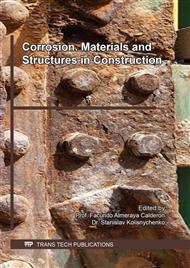[1]
Hou Baorong, et al., 2017-The cost of corrosion in China.
Google Scholar
[2]
Hou Baorong, Li Xiaogang, Ma Xiumin, et al., The cost of corrosion in China. npj Materials Degradation, Volume 1, Issue 4, (2017) 1-10.
Google Scholar
[3]
Wang Fazhou, LIU Zhi-chao, WANG Tao, et al., A novel method to evaluate the setting process of cement and asphalt emulsion in CA mortar, Materials and Structures, Volume 41, Issue 5, (2008) 643-647.
DOI: 10.1617/s11527-007-9270-9
Google Scholar
[4]
Jiang Jianhua, Yuan Yingshu, Li Fumin, et al. Comparative Study on Corrosion Behavior of Steel Bars of Different Grades in Concrete, Journal of building materials, Volume 12, Issue 5, (2009) 523-527.
Google Scholar
[5]
He Yong, Tang Xianxi, Sun Shuaihu, et al., Experimental study on corrosion resistance of reinforced concrete bridge based on electrochemical corrosion, China concrete and cement products, Issue 9, (2018) 1-6.
Google Scholar
[6]
Kang Yue, Li Gangi, Jin Zuquan, et al., Corrosion Behavior of Reinforced Bar in Concrete in Marine Environment, Tunnel construction, Volume 38, Issue 12, (2018) 1966-1974.
Google Scholar
[7]
Qiao Hongxia, Wen Shaoyong, Guo Xiangke, et al., Study on corrosion of coated reinforced magnesium oxychloride cement concrete, Journal of functional materials, Volume 50, Issue 4, (2019) 04108-04120.
Google Scholar
[8]
Ding Wei, Cui Guohui, Test and research of influences of reinforcing bar rust on the cracking of concrete protection layer and mechanics performances of reinforcing bar in concrete under the condition of atmosphere, Concrete, Issue 1, (2000) 38-41.
Google Scholar
[9]
Wang Xianli, Zheng Jianjun, Experimental study of corrosion-induced crack initiation and propagation of reinforced concrete structures, Journal of Dalian University of Technology, Volume 49, Issue 2, (2009) 246-253.
Google Scholar
[10]
Yuan Yingshu, Jia Fuping, Cai Yue, Deterioration of mechamical behavior of corroded steelbar, Industrial Construction, Volume 30, Issue 1, (2000) 43-46.
Google Scholar
[11]
Du Yingang, Clark LA, Chan A H C, Residual capacity of corroded reinforcing bars, Magazine of Concrete Research, Volume 57, Issue 3, (2005) 135-147.
DOI: 10.1680/macr.2005.57.3.135
Google Scholar
[12]
Wu Qing, Yuan Yingshu, Experimental study on the deterioration of mechanical properties of corroded steel bars, China civil engineering journal, Volume 41, Issue 12, (2008) 42-47.
Google Scholar
[13]
Dimitri V Val, Mark G, Stewart and Robert E, Melchers, Effect of reinforcement corrosion on reliability of highway bridges, Engineering structure, Volume 20, Issue 11, (1998) 1010-1019.
DOI: 10.1016/s0141-0296(97)00197-1
Google Scholar
[14]
Zhang Jianren, Zhang Kebo, Peng Hui, et al., Calculation Method of Normal Section Flexural Capacity of Corroded Reinforced Concrete Rectangular Beams, China Journal of Highway and Transport, Volume 22, Issue 3, (2009) 45-51.
Google Scholar
[15]
Jnaid F, Aboutaha R S, Residual flexural strength of corroded reinforced concrete beams, Engineering Structures, Volume 119, Issue 7, (2016) 198-216.
DOI: 10.1016/j.engstruct.2016.04.018
Google Scholar
[16]
Yang Xiaoming, Cheng Chunhui, Chen He, Condition assessment of corroded reinforced concrete component considering Degradation of Load Carrying Capacity, Bulletin of the Chinese ceramic society, Volume 37, Issue 3, (2018) 837-843.
Google Scholar
[17]
He Hongzhu, Cui Yuli, Shi Meilun, et al., Real time monitoring of corrosion of rebar in Concrete, Journal of bulding materials, Volume 16, Issue 1, (2013) 50-54.
Google Scholar
[18]
Huang Junlin, Zhang Wenbo, Qiu Xiangyang, et al., Research on CBM Pipeline Corrosion and Service Ability Assessment, Environmental Impact Assessment, Volume 40, Issue 6, (2018) 55-58.
Google Scholar



